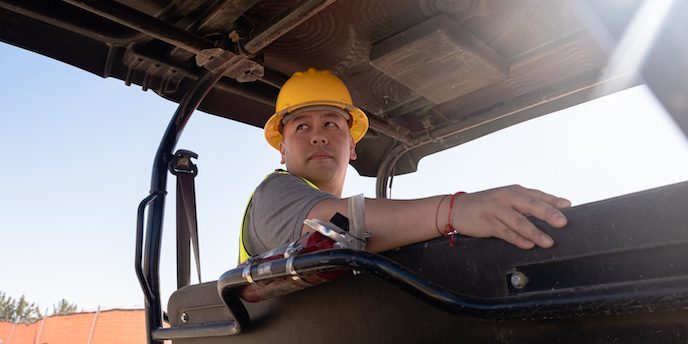


Some might say sustainability and construction will never go together. In the eyes of Rachel Connor, this is a huge opportunity for the industry to come together and make it a win-win for everyone. There’s no doubt, resources are scarce — and in today’s current market situations construction materials are also incredibly expensive — so the task at hand is how we use materials smarter to create more impact and less waste and pollution.
The push for doing business more sustainably comes from the market, but also from legislation and a new generation entering the workforce in construction, looking beyond mere profit. More than a way to attract new customers and projects, reducing construction’s environmental footprint is also a requirement for attracting scarce talent. “The real magic happens when all these three things come together,” says Connor. “A desire to do the right thing and to look at it holistically.”
But how to get moving? How to translate the big ideas into actionable items? “We need to tell the success stories that are already out there” says Connor. While there’s a lot of questions still unanswered, there’s a ton of great examples out there already where people experiment and put different approaches to the test.
One of the approaches for more sustainable business operations is to involve people on all organizational levels. Because solutions need to work in the long term, but also on the ground.
In a rather unconventional move, Skanska merged two functions in one person. Skanska put its corporate equipment manager Mason Ford, member of the AEMP sustainability taskforce, in charge of sustainability combining hands-on experience in the field with the power to make decisions. That has enabled him to have impact on picking the right tool and equipment for the job and properly influencing others in the organization.
‘The real magic happens when all these three things come together. A desire to do the right thing and to look at it holistically.’
Another example where this approach is useful is the electrification of fleets. One of the most discussed strategies to reduce fleet CO2 emissions, there’s still a lot of practical challenges that need to be solved. “How does electrification work in the field when jobs are 24/7, and there’s infrastructure and charging ports missing? How are things done in the real world?” says Connor.
Aside from identifying and overcoming operational hurdles, behavioral change is another key component that will move the needle. To change habits at scale, establishing benchmarks to compare against is key.
“The hardest part to get our heads around is measurement of sustainability efforts.” says Connor. That’s a challenge on an industry level, but it’s possible and important to start setting benchmarks internally.
Reducing idle time is one piece of the puzzle to a more sustainable construction industry. It’s a good example of benchmarking as a powerful tool to make impact visible and to motivate change across the workforce. It’s estimated that the average idle time in construction is at 36% and reducing this type of downtime is of advantage to the bottom line and the environment.
A case study on reducing idle time shows that visualizing how individual behavior contributes to a bigger goal can incentivize significantly more efficient and safer driving behavior. In this particular case, different parameters, amongst others idle time, were summarized in a driver score visible to employees. Emphasis was then put on coaching and providing resources to help people improve where necessary.

With everyone knowing exactly what type of behavior will contribute to using less fuel, the organization was able to reduce carbon footprint and also cut down maintenance cost as a bonus as drivers were treating their vehicles more carefully. To get people truly involved though, such an approach can never be abused as a system for monitoring behavior. It needs to remain incentive-based.
Digitization and sustainability both come down to efficiency and providing people with the right tools to support them. Getting the right data at the right time to the right person is what defines success in reaching targets such as CO2 reductions set by international treaties and agreements. Access to the right data at the right time is important for those with boots on the ground on construction sites every day, as well as to those who make the strategic decisions affecting organizations in the long run. To enable the construction industry to measure what matters, it requires transparency, overview and benchmarking.
‘This industry is built up on a lot of people who really push forward.’
When it comes to tech and systems to deliver actionable insights, you have to take into account how the end-user is using it. Creating environments in which humans can do their job well and thrive should be a principle in all efforts around sustainability.
“Sustainability can’t just be about the planet,” Connor adds. “It’s all connected and has to work together.”
“Let’s give credit where credit is due because construction is not just a bunch of people who don’t care,” she says. “This industry is built up on a lot of people who really push forward.”
Are you inspired by this story? To receive three insightful reads on data, strategy and tech from people across the construction industry in your inbox once a month, sign up to the Eliminate Downtime newsletter.

